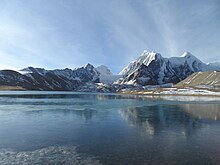Gurudongmar Lake
| Gurudongmar Lake | |
|---|---|
| Coordinates | 28°01′N 88°43′E / 28.02°N 88.71°E |
| Basin countries | Sikkim, India |
| Max. length | Gurudongmar Lakeʍ |
| Surface area | 118 hectares (290 acres) |
| Shore length1 | 5.34 kilometres (3.32 mi) |
| Surface elevation | 16,909 ft (5,154 m) |
| Settlements | Mangan, North Sikkim 122 km. Lachen, North Sikkim 67 km. |
| 1 Shore length is not a well-defined measure. | |
Gurudongmar Lake is one of the highest lakes in the world and in India, at an elevation of 5,430 m (17,800 ft) according to the
Geography

The high altitude lake is located 190 kilometres (120 mi) away from
Features
The lake is fed by the Gurudongmar glacier and is a
The lake has an area of 118 hectares (290 acres) and its peripheral length is 5.34 kilometres (3.32 mi).
The lake is fresh water and used to be very clear; the bed of the lake could even be seen from the middle of the lake. Pollution has muddied the waters in recent years, and the lake has taken on a white tinge and has obscured visibility.[1]
In folklore

In Buddism
Guru Padmasambhava, on his way back from Tibet, visited the holy Dorje Nyima lake, which remained frozen for most of the year. The locals called upon him to help them. After touching a small section of the lake, it never froze again, solving the water problem for the people. The lake became holy and an important place for Buddhist pilgrimage, ensuring the lake's continued existence.[8][9]
In Sikhism
The Sikhs believed Guru Nanak visited and blessed the lake, leading to the construction of a Gurudwara in 1997-1987, which clashed with local Buddhists.[8][9]
Dispute

A dispute arose when on the bank of the lake an
Images



See also
- Tourism in North East India
- Tilicho lake
- Lake Tsongmo
- Khecheopalri Lake
- Sanglaphu
Notes
References
- ^ a b c d e "Gurudongmar Lake (North Sikkim Tourist Places)". District North Sikkim, Government of Sikkim.
- ^ a b "Gurudongmar Lake". Official website of Sikkim Tourism, Government of Sikkim.
- ^ Gurudongmar, OpenStreetMap, retrieved 18 November 2021.
- ^ a b c d Panigrahy, S; Patel, J G; Parihar, J S (September 2012). "National Wetland Atlas: High Altitude Lakes Of India" (PDF). Gurudongmar Lake. Space Applications Centre, ISRO, Government of India. p. 83.
- ISBN 978-1-907263-88-0.
- ISBN 9789811598050.
- ISBN 978-1-259-00090-4.
- ^ ISSN 0971-8257. Retrieved 27 November 2023.
- ^ a b "সিকিমের গুরুদোংমার হ্রদের কিংবদন্তি সম্পর্কে জানেন কি?". Eisamay (in Bengali). Retrieved 27 November 2023.
- ISBN 978-81-86565-90-2.

